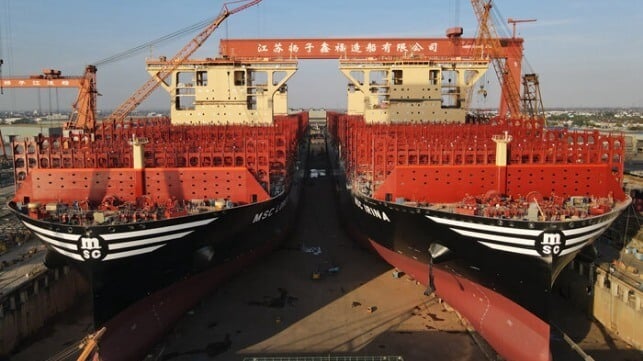Container Fleet Adds Record Capacity as Orders Become Deliveries

The global containership fleet continues to experience record capacity growth in the number of TEU capacity added to the fleet in 2023 and again so far this year. While industry executives continue to express concern over the mid-term overhang on capacity near-term it has helped to offset the impact of the diversions away from the Red Sea and the lower number of daily transits at the Panama Canal.
Industry trade group BIMCO calculates that 2,3 million TEU of containership capacity was delivered in 2023, beating a previous record by 37 percent. To put these volumes in perspective, Alphaliner calculates the global container fleet numbers just over 6,900 vessels with a total capacity exceeding 29.6 million TEU.
The pace of new deliveries has not slowed in 2024. BIMCO reports another new record has been set so far this year. They calculate that more than 1 million TEU capacity was delivered in the first four months of 2024. That represents an 80 percent increase compared to the previous record.
“Despite this, deliveries are still some way off the record when seen in relation to the size of the fleet,” notes Niels Rasmussen, the Chief Shipping Analyst at BIMCO. “In 2024, we expect deliveries to reach 11 percent of fleet capacity at the beginning of the year. That was most recently beaten in 2008 when deliveries made up 14 percent of the fleet.”
BIMCO notes that despite the deliveries the orderbook volume remains very high. Even after the 1 million TEU capacity delivered in 2024, they highlight the orderbook stands at 6.1 million, which represents 21 percent of the current fleet size. Offsetting the deliveries are an additional 1.8 million TEU of capacity that was ordered in 2023 and 2024.
“The orderbook’s share of fleet is more than twice the size than it was before the COVID pandemic and liner operators’ contracting spree began,” says Rasmussen.
The pace of deliveries is expected to continue through 2024 and into 2025. BIMCO calculates that a further 2 million TEU of capacity will be delivered in the remainder of 2024, bringing the yearly total to over 3 million TEU of capacity. That would exceed last year’s record by 30 percent. Further, deliveries in 2025 will slow but remain at nearly 2 million TEU. BIMCO calculates that will be the third highest deliveries in one year only exceeded by 2023 and 2024.
“The record high ship deliveries were expected to create significant oversupply in the market, and while this did impact the market in 2023, it appears that deliveries this year instead contribute to keeping global container trade moving,” says Rasmussen.
Due to the rerouting of ships via the Cape of Good Hope following attacks in the Red Sea by Houthis, BIMCO says about 10 percent more capacity is needed to manage global container trades. Capacity needed to manage any market growth should be added to those 10 percent said Rasmussen. Last week, Maersk predicted that the rerouting away from the Red Sea on the routes between Asia and Europe would require up to 20 percent of the industry capacity this quarter.
Maersk CEO Vincent Clerc however warned that the market overhand remains predicting that overcapacity would begin to be an issue later in 2024 and 2025. Other industry CEOs including Rolf Habben Jansen of Hapag-Lloyd have also repeated the concerns about sector overcapacity due to all the new vessels.
BIMCO says that when ships start increasing sailings via the Red Sea and the Suez Canal, it expects to most likely see a significant oversupply. Between 2019 and 2023, BIMCO notes the containership fleet grew 21 percent while container volumes only grew four percent. Between 2023 and 2025, the fleet is expected to grow another 15 percent concludes BIMCO.
